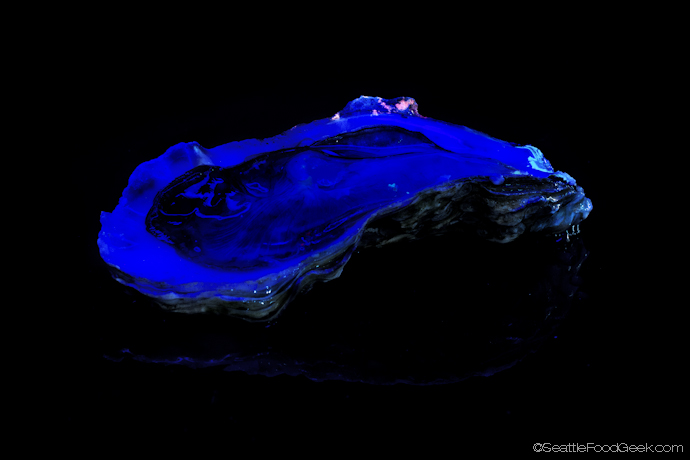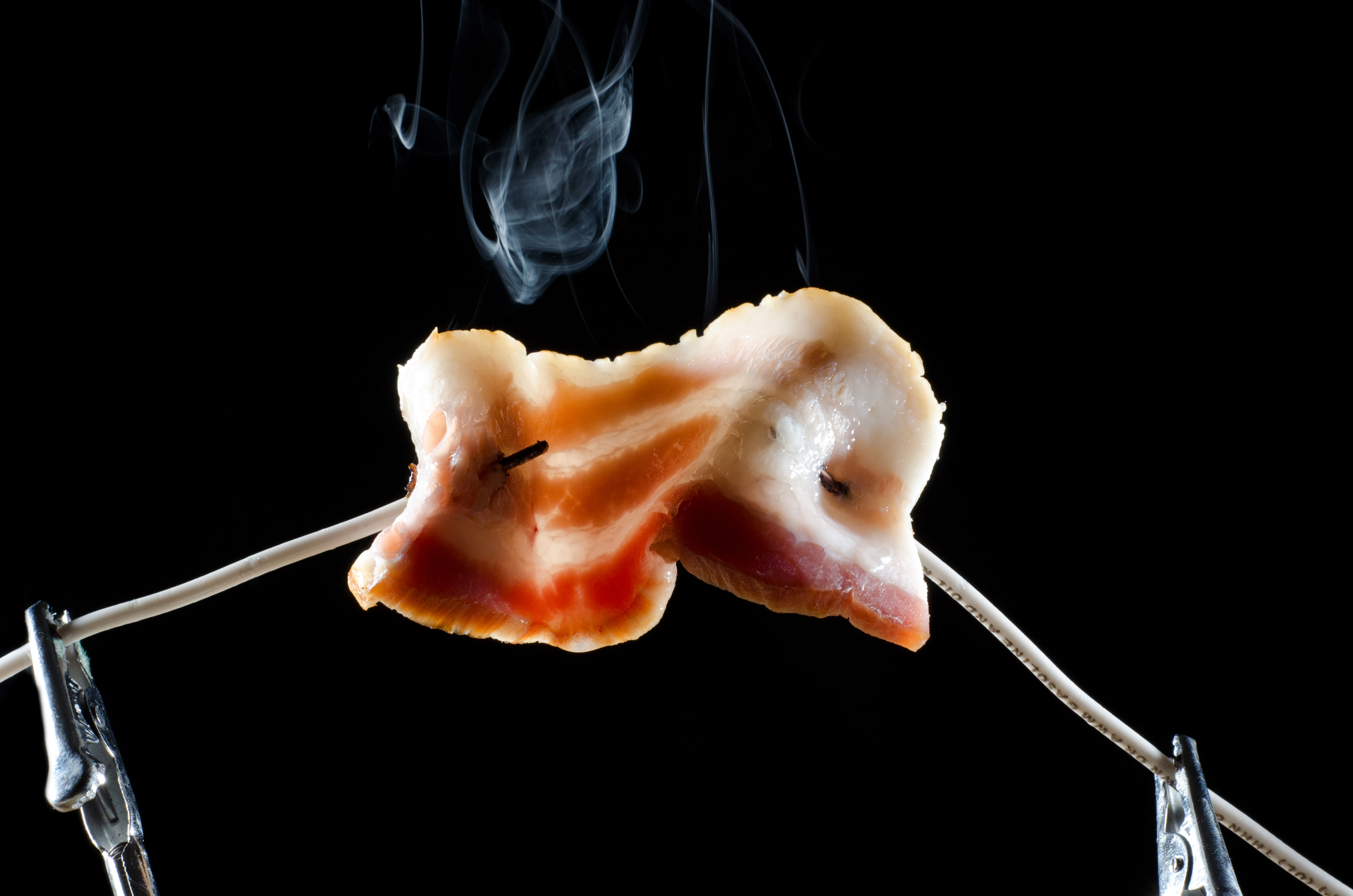
I really wanted to make glow-in-the-dark oysters. More accurately, I wanted to make oysters fluoresce under ultraviolet light (sometimes called “black light”). Why? Because it’s cool, of course. [If you were hoping for a more noble, practical reason, you’re probably reading this blog by mistake.]
I knew two things before beginning this experiment: 1) the quinine in tonic water fluoresces under UV light, and 2) oysters are “filter feeders,” meaning they trap particles from the water as a means of taking in nutrients. Modernist Cuisine includes a recipe, which is an adaptation from Dave Arnold and Nils Noren, for Beet Juice-Fed Oysters (book 3, page 206). The recipe calls for submerging live oysters in beet juice strained through a 500 micron sieve and letting them feed for 48 hours. The flesh of the oyster turns pink and red as it takes on the microscopic particles of beet juice.
Following this example, I thought there was a good chance that the oysters might filter the quinine out of tonic water in the same way, leading to slightly sweetened oysters that would glow iridescent blue under a black light. In my experiment, however, they did not. The picture you see above is one of my test oysters under a fluorescent UV bulb. Although it looks cool in the photo, it is very much not fluorescing. If I put a white cloth next to the oyster, the cloth lit up like a warehouse rave, but the oyster was only reflecting the bluish hue of the visible light from the UV blub. Interestingly, a portion of the shell just at the hinge is fluorescing (it’s a brighter blue-green in the picture) but I did not achieve my intended result of an iridescent mollusk.
Why didn’t it work? I have a few theories:
- Perhaps the oysters were DOA. Shamefully, I purchased the oysters at the type of grocery store that also sells name-brand cola and US Weekly. I should have known better, and I’ll never do it again, but it’s quite possible that these fugly-ass oysters were dead before I got them home.
- Salt problem? The Modernist Cuisine recipe calls for 2.6% aquarium salt. I’m not sure what that is, so I used regular table salt. Perhaps that’s an important difference.
- Is tonic water lethal to oysters? The shells were still tightly closed when I removed them. I did notice that, for about 30 minutes after I covered the oysters in tonic water, they were releasing a constant stream of very small bubbles from the edges of their shells. I assume this was a result of them circulating the water through their muscular little bodies. But perhaps the fact that the bubbles stopped after 30 minutes is evidence that they didn’t survive the pre-cocktail environment of a bottle of Canada Dry.
- The quinine in tonic water might be inaccessible to the oyster’s filtration system. Either the quinine particles are too large, too small, or for some other reason can’t be filtered by the oysters.
- Not enough quinine? Perhaps everything did work as I anticipated, but the concentration of the quinine was just to weak to show up in the oyster bodies.
I may repeat this experiment with higher-quality oysters and additional quinine. Alternately, if any geneticists out there want to grab the fluorescence gene from a modified zebrafish and put it into a Samish Sweet or a Blue Pool, I’ll gladly shuck and slurp with you!

Most highlighter dyes fluoresce under black light. There may even be food safe variations available. No promise that they are oyster safe though.
My bet would be that quinine is toxic to the oysters. That, and the other salts in tonic water. Oysters are pretty fragile outside of their native ocean water environment…
Perhaps the carbonated water is the problem… Consider soaking the oysters in Puget Sound water and dissolving quinine tablets in the water.
Aquarium salt is basically sea salt… though I’m not sure I’d put aquarium salt on my food or culinary sea salt in an aquarium…
Damn that would have been a fun dinner party.
Curcumin in turmeric also fluoresces, so you could try adding turmeric. Not sure what wavelength your blacklight is. But your oysters might glow yellow!
Aquarium salt is found at fish stores and contains a variety of trace elements required for marine fish, corals and inverts to survive. Now, you might be concerned about what those elements are and their quantities, but the reality is they are suppose to mimic real ocean water. So when you pull oysters out of the ocean, the water in them should be (essentially) no different than what you’d use to mix in an aquarium . The only problem is that aquarium salt is NOT cheap, and you usually can’t get it in small amounts. You’ll end up with $50 worth of aquarium salt you have no idea what to do with.
I know a bit about aquariums and aquarium salt is especial. it also comes with other things that marine fish need to survive. I’m thinking the salt was to let the oysters live. If they weren’t DOA, the sure died in the fresh table salted water.
First, some definitions:
quinine = molecule
beet particle = particle
molecule = super freaking tiny, like nanometers in dimension at most
particle = 100x to 100,000x times bigger
Oyster = filter feeder
filter = something that lets particles get trapped, while smaller things get passed through. Smaller things, like water and other molecules.
And, as others have said before me… “I have discovered a marvelous proof for this theorem which this margin is too small to contain.”
But now, if you want to order/buy/steal some green fluorescent protein and mix it up with the oyster food, that might be worth a try.
Pingback: MUI7GLkEnc MUI7GLkEnc